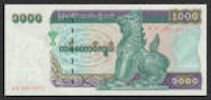The first coins were issued in Myanmar by the kings of the Chandra Dynasty of the kingdom of Arakan in the seventh or eighth century AD. The Pyu and Mon people also issued coins during the eighth century.
Burma was united in the mid eleventh century when the Burmese people invaded present-day Myanmar. No coins were issued between the eleventh century and the sixteenth century, though silver coins from Bengal began circulating in the fourteenth century. The Arakan kings continued to issue coins until 1784 when the Burmese king Bodawpaya (1782-1819) conquered the Arakan. Bodawpaya issued coins imitating those of both the Arakan and Pyu. The Tenasserim, who lived in the south of Myanmar issued large lead coins, some 80 mm in diameter, between the seventeenth and eighteenth centuries.
In three wars from 1824 to 1885, the British conquered all of Burma. From 1852, British troops occupied coastal Burma. Under the Burmese king Mindon Min (1853-78) coins were minted in Mandalay using modern machinery from England. The coins matched contemporary Indian coins with 1 Kyat = 20 pe.
The Kingdom of Awa was annexed to British India on January 1, 1886. Under British control, Burma became a province of India. On April 1, 1937 mostly Buddhist Burma became a separate colony from mostly Hindu India. Burma was occupied by Japan from August 1, 1942 until May 3, 1945. In 1945, Burma fell under British military rule, under British civilian rule in 1946, and an interim Burmese government was established in 1947. Burma gained its independence as the Union of Burma on January 4, 1948, and was renamed the Union of Myanmar on June 18, 1989.
The British standardized the silver Rupee (INR) throughout India. Banknotes were issued by the Government of India. Indian government notes redeemable only in Rangoon began to be issued in August 1883 (by India, Act No. 20 of 1882). Burmese-issued coins were demonetized on 1 April 1892.
The Indian Silver Rupee was used in Myanmar from 1886 until April 1, 1939 when Indian currency ceased to be legal tender in Burma. On April 1, 1937, Burma began issuing its own Rupee (BUR) banknotes through the Reserve Bank of India. Burma was part of a currency union with India until World War II began.
When invading Burma during the Second World War, from about 31 January 1942, Japanese forces initially carried Japanese military dollars issued in Malaya. A decree of the Japanese military administration dated 1 May 1942 stated that Japanese military dollars would continue to be legal tender. By the same decree, the Japanese military rupee (BUG) became a decimal currency. By the regulation of 15 March 1943, the Burmese rupee continued to be legal tender, as a Japanese tactic to win local support, but the rupee was inconvertible into pound sterling. Limited amounts of (Burmese) Indian rupees were apparently accepted by the Japanese at 4 (Burmese) Indian rupees = 1 Japanese military rupee. The prewar exchange rate had been about 1.3 Japanese yen = 1 (Burmese) Indian rupee. On 1 May 1942, the Japanese military commander-in-chief in Burma declared that Japanese military dollars for Malaya and Singapore would also be allowed to circulate in Burma.
The Japanese also created the Burma State Bank on January 15, 1944 to issue banknotes. The Japanese divided the Rupee into 100 cents, whereas the British had divided the Rupee into 16 Annas as in India. The British demonetized Japanese occupation currency on 1 May 1945. The market exchange rate had fallen to 100 Southern Development Bank rupees = 1 Indian rupee.
The British Military Administration issued banknotes between May 1, 1945 and January 30, 1946, the government of Burma issued notes between January 31, 1946 and March 30, 1947, and on April 1, 1947 the Burma Currency Board was formed to issue banknotes. The Government of Burma issued banknotes between 1948 and 1953.
The Kyat (BUK) replaced the Rupee at par on July 1, 1952 when the Union Bank of Burma replaced the Burma Currency Board, and the Myanmar Kyat (MMK) replaced the Burmese Kyat on June 18, 1989. The Kyat is divisible into 100 Pya. The Union Bank of Burma was established on February 3, 1948 and was given the exclusive right to issue banknotes in Burma. The bank's name was changed to the People's Bank of the Union of Burma on November 1, 1969, the Union Bank of Burma on September 30, 1972, and the Central Bank of Myanmar in 1990.
The Government of Myanmar has also issued Foreign Exchange Certificates (MMX) denominated in Dollars for foreign visitors.


